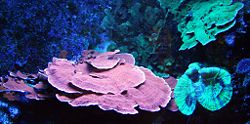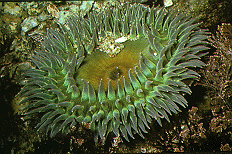Difference between revisions of "Anthozoa" - New World Encyclopedia
Rick Swarts (talk | contribs) |
Rick Swarts (talk | contribs) |
||
| Line 29: | Line 29: | ||
==Behavior, feeding, and reproduction== | ==Behavior, feeding, and reproduction== | ||
| + | [[Image:Giant Green Anemone.gif|thumb|250px|right|[[Giant green anemone]], likely ''Epicystis crucifer'', Southern [[California]]]] | ||
| + | Members of most species of Anthozoa are suspension feeders, capturing small planktonic [[invertebrate]]s, [[phytoplankton]], bacteria, and other suspended organic matter (France 2004). Most common are passive methods of capturing prey, when it comes in contact with the tentacles. All cnidarian species can feed by catching prey with [[cnidocyte|nematocyst]]s, with large sea anemones capable of catching [[fish]], [[crab]]s, and [[bivalve]]s, and corals are capable of catching [[plankton]]. | ||
| + | |||
| + | Some of the anthozoan species harbor a type of [[algae]], [[dinoflagellate]]s called [[zooxanthella]]e, in a [[symbiotic]] relationship. The reef building corals known as hermatypic corals rely on this symbiotic relationship particularly. The zooxanthellae benefit by using nitrogenous waste and carbon dioxide produced by the host, and the cnidarian gains photosynthetic capability and increased [[calcium carbonate]] production in hermatypic corals (Madl and Yip 2000). | ||
| + | |||
| + | Various reproductive strategies are utilized by anthozoans, including production of asexual clones by fission (in longitudinal or transverse direction) and pedal laceration (where pieces of the pedal disk separate and develop new individuals) and fragmentation, and anthozoans may have separate sexes or be hermaphroditic (France 2004). Gametes typically are released through the mouth for external fertilization or eggs may be retained for internal fertilization and embryos released through the mouth (France 2004). The ciliated planula larvae that develop from the embryos may or may not feed (France 2004). Some species can produce larvae asexually (France 2004). | ||
| − | |||
| − | |||
Anemones and certain species of coral live in isolation, however most corals form colonies of genetically identical polyps; these polyps closely resemble anemonies in structure, although are generally considerably smaller. Most kinds of [[Deep water coral|stony coral]] live in all parts of the underwater world. | Anemones and certain species of coral live in isolation, however most corals form colonies of genetically identical polyps; these polyps closely resemble anemonies in structure, although are generally considerably smaller. Most kinds of [[Deep water coral|stony coral]] live in all parts of the underwater world. | ||
| − | [ | + | |
| + | |||
| + | |||
| + | |||
| + | <ref name=MilneBay>[http://www.sbg.ac.at/ipk/avstudio/pierofun/png/png3.htm PART-III Cnidaria (Gk. cnidos, stinging nettle) reproduction and growth of Scleractinia: | ||
| + | |||
| + | Contribution to the BUFUS Newsletter, Field excursion to Milne Bay Province - Papua New Guinea, P. Madl and M. Yip 2000] | ||
| + | </ref> | ||
== Phylogeny == | == Phylogeny == | ||
Revision as of 21:47, 2 August 2008
| Anthozoa | ||||||
|---|---|---|---|---|---|---|
 Stony corals, Scleractinia
| ||||||
| Scientific classification | ||||||
|
Anthozoa is a class of marine invertebrates within the phylum Cnidaria that are unique among cnidarians in that they do not do not have a medusa stage in their development. These exclusively polypoid cnidarians are characterized by a tubular body with tentacles around the mouth and most are sedentary after the larval stage. Anthozoa includes the sea anemones, corals, sea pens, sea pansies, and sea fans, among others.
Anthozoa is the larges of the four classes of Cnidaria with over 6,000 species (France 2004). They are found worldwide in all oceans, from the Arctic to the Antarctic. Anthozoa means "flower animals," which is descriptive of this class of invertebrates.
Overview
Anthozoa is one of four classes of the invertebrate phylum, the others being Hydrozoa (Portuguese Man o' War, Obelia, etc.), Scyphozoa (true jellyfish), and Cubozoa (box jellies). All are aquatic and most are marine. The name of the phylum comes from cnidocytes, which are specialized cells that carry stinging secretions that are are the cnidarians' main form of offense or defense and function.
The basic body shape of a cnidarian consists of a sac with a gastrovascular cavity, with a single opening that functions as both mouth and anus. It has radial symmetry, meaning that whichever way it is cut along its central axis (that is, by any plane that passes through its longitudinal axis), the resulting halves would always be mirror images of each other.
Theoretically, members of Cnidaria have life cycles that alternate between asexual polyps (the body as a vase shaped form), and sexual, free-swimming forms called medusae (singular medusa; the body in a bell-shaped form). However, members of Anthozoa live only as polyps. The anthozoa larva, once fusing with the substratum and developing into the polyp stage, grows benthic or sessile, meaning it no longer metamorphoses into the medusal stage. (Members of Scyphozoa live most of their life cycle as medusa, the Hydrozoa live as polyps, medusae, and species that alternate between the two, and those of the class Cubozoa are named for their cube-shaped medusae, which form the dominant part of their life cycle.)
Description
Anthozoans are essentially a tubular sac, with a mouth and tentacles position around the mouth on a flattened upper surface known as an oral disk. As with other cnidarians, the tentacles surrounding the mouth have stinging cells and the mouth is the only entry to the digestive system (France 2004).
Anthozoans are only found in marine environments. They can be found in habitats from the intertidalzone to over 6,000 meters (19,500) feet deep (France 2004). Species may be solitary or colonial. While solitary forms may attach to a hard substrate or burrowed into soft mud or sand on the sea bed, the colonial forms may build massive skeletons, such as the reef-building corals.
Larval forms are free moving, but most adult forms are sedentary; some groups, such as those of the orders Actiniaria (sea anemones), Ceriantharia (tube anemones), and Pennatulacea (sea pens and sea pansies) may show some movement.
Behavior, feeding, and reproduction

Members of most species of Anthozoa are suspension feeders, capturing small planktonic invertebrates, phytoplankton, bacteria, and other suspended organic matter (France 2004). Most common are passive methods of capturing prey, when it comes in contact with the tentacles. All cnidarian species can feed by catching prey with nematocysts, with large sea anemones capable of catching fish, crabs, and bivalves, and corals are capable of catching plankton.
Some of the anthozoan species harbor a type of algae, dinoflagellates called zooxanthellae, in a symbiotic relationship. The reef building corals known as hermatypic corals rely on this symbiotic relationship particularly. The zooxanthellae benefit by using nitrogenous waste and carbon dioxide produced by the host, and the cnidarian gains photosynthetic capability and increased calcium carbonate production in hermatypic corals (Madl and Yip 2000).
Various reproductive strategies are utilized by anthozoans, including production of asexual clones by fission (in longitudinal or transverse direction) and pedal laceration (where pieces of the pedal disk separate and develop new individuals) and fragmentation, and anthozoans may have separate sexes or be hermaphroditic (France 2004). Gametes typically are released through the mouth for external fertilization or eggs may be retained for internal fertilization and embryos released through the mouth (France 2004). The ciliated planula larvae that develop from the embryos may or may not feed (France 2004). Some species can produce larvae asexually (France 2004).
Anemones and certain species of coral live in isolation, however most corals form colonies of genetically identical polyps; these polyps closely resemble anemonies in structure, although are generally considerably smaller. Most kinds of stony coral live in all parts of the underwater world.
Phylogeny
The two subclasses are divided into a number of orders[2] and a series of orders.[3][4][5][6], extinct orders from the Paleozoic (570-245 m.y.a.)[7] are marked with †.
- Subclass Alcyonaria (= Octocorallia) (8-way symmetry)
- Alcyonacea (soft corals)
- Gorgonacea (sea fans, sea feathers)
- Helioporacea (= Coenothecalia) (Indo-Pacific blue coral)
- Pennatulacea (sea pens, sea pansies)
- Stolonifera (organ-pipe coral, tree fern coral)
- Telestacea (soft corals)
- Subclass Zoantharia (= Hexacorallia) (6-way symmetry)
- Ceriantharia (tube-dwelling anemones)
- Actiniaria (sea anemones)
- Corallimorpharia
- Numidiaphyllida †
- Scleractinia (= Madreporaria) (stony corals)
- Kilbuchophyllida †
- Antipatharia (black corals, thorny corals)
- Zoanthidea
- Heterocorallia †
- Rugosa † (= Tetracoralla) (horned corals)
- Heliolitida †
- Tabulata † (tabulate corals)
- Cothoniida †
- Tabuloconida †
- Ptychodactiaria
ReferencesISBN links support NWE through referral fees
- ↑ [http://www.sbg.ac.at/ipk/avstudio/pierofun/png/png3.htm PART-III Cnidaria (Gk. cnidos, stinging nettle) reproduction and growth of Scleractinia: Contribution to the BUFUS Newsletter, Field excursion to Milne Bay Province - Papua New Guinea, P. Madl and M. Yip 2000]
- ↑ Fautin, Daphne G. and Romano, Sandra L. (2000). Anthozoa. Sea Anemones, Corals, Sea Pens.. The Tree of Life Web Project. Retrieved 2006-03-31.
- ↑ Chen, C. A., D. M. Odorico, M. ten Lohuis, J. E. N. Veron, and D. J. Miller (June 1995). Systematic relationships within the Anthozoa (Cnidaria: Anthozoa) using the 5'-end of the 28S rDNA. Molecular Phylogeny and Evolution 4 (2): 175–183.
- ↑ France, S. C., P. E. Rosel, J. E. Agenbroad, L. S. Mullineaux, and T. D. Kocher (March 1996). DNA sequence variation of mitochondrial large-subunit rRNA provides support for a two subclass organization of the Anthozoa (Cnidaria). Molecular Marine Biology and Biotechnology 5 (1): 15–28.
- ↑ Myers, P., R. Espinosa, C. S. Parr, T. Jones, G. S. Hammond, and T. A. Dewey (2006). Subclass Alcyonaria. The Animal Diversity Web (online). Retrieved 2006-03-31.
- ↑ Ben Kotrc (2005). Anthozoa: Subgroups. Fossil Groups. University of Bristol. Retrieved 2007-04-09.
- ↑ Oliver, W. A., Jr. (1996). "Origins and relationships of Paleozoic coral groups and the origin of the Scleractinia", in G. D. J. Stanley (ed.): Paleobiology and Biology of Corals. Columbus, Ohio: The Paleontological Society, 107-134.
Credits
New World Encyclopedia writers and editors rewrote and completed the Wikipedia article in accordance with New World Encyclopedia standards. This article abides by terms of the Creative Commons CC-by-sa 3.0 License (CC-by-sa), which may be used and disseminated with proper attribution. Credit is due under the terms of this license that can reference both the New World Encyclopedia contributors and the selfless volunteer contributors of the Wikimedia Foundation. To cite this article click here for a list of acceptable citing formats.The history of earlier contributions by wikipedians is accessible to researchers here:
The history of this article since it was imported to New World Encyclopedia:
Note: Some restrictions may apply to use of individual images which are separately licensed.